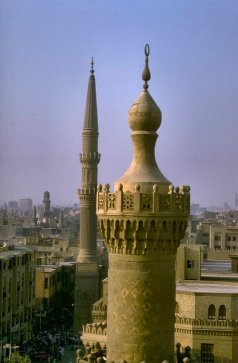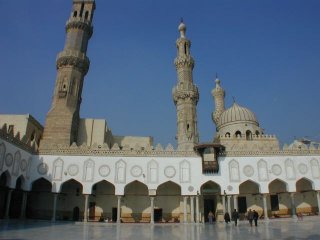A l A z h a r
[by Mutmainaa]

Al-Azhar was founded (and designed) by Jawhar As-Siqilli on 7th Ramadan, 361 AH, upon the order of the Fatimid Caliph Al-Mu'izz LiDinAllah.
When Jawhar As-Siqilli, ordering as a head of Al-Mu'izz LiDinAllah, first Caliph of the dynasty of Fatimides, conquered Egypt and founded the city of Cairo, it started the construction of the Mosque Al-Azhar in the month of Jumad Al-Awwal 359 A.H.
There is some disagreement on how the mosque got its name. Some historians are of the view that it got its name because it was surrounded by flourishing mansions at the time when Cairo was founded. Others hold that it is called "Al-Azhar" after Fatima al-Zahraa, daughter of the Prophet Muhammad
Al Azhar is located in El Hossein Square, Cairo, Egypt. It stands opposite Al Hussein Square, its five minarets forming a distinguished part of the Cairo skyline.
Al Azhar means "The Most Blooming", and was built in 972 (361 H), as the main mosque of the new city of Cairo just shortly before the founding of Cairo itself.
It imitated both the Amr Ibn El-As and Ibn Tulun mosques in style, being built within two years and opened for it's first prayers on 7th Ramadan 361 A.H / June 22, 972 AD.
It was under Yaqub ibn Cals that the masjid became a teaching institute, with its staff of teachers chosen from among the judges and Muhtasibun (Muslim vigilantes). The first lecture was delivered in 975 AD, making it the oldest university in the world!
Today the university built around the masjid is the most prestigious of Muslim schools, and its students are highly esteemed for their traditional training.
While ten thousand students once studied here, today the university classes are conducted in adjacent buildings and the masjid is reserved for prayer. In addition to the religious studies, modern schools of medicine, science and foreign languages have also been added.
Certain Western academic traditions are based on the practice at Al Azhar. The robes of Azhar students were copied for European academic gowns (as those today worn by students when graduating), and the notion of granting a head of department the chair in his subject arose because Azhar students used to sit at the feet of their teacher whose privilege it was to occupy a chair.
Cross the courtyard into the mosque proper. This area, too, has been changed and rebuilt. Virtually the only Fatimid part remaining of the original mosque is the prayer niche in the south-east wall.
Architecturally, the mosque is a palimpsest of all styles and influences that have passed through Egypt, with a large part of it having been renovated by Abdarrahman Khesheda. There are five very fine minarets with small balconies and intricately carved columns. It has six entrances, with the main entrance being the 18th Century Bab el-Muzayini (barber's gate), where students were once shaved. This gate leads into a small courtyard and then into the Aqbaughawiya Medersa to the left, which was built in 1340 and serves as a library. On the right is the Taybarsiya Medersa built in 1310 which has a very fine mihrab. The Qaitbay Entrance was built in 1469 and has a minaret built atop. Inside is a large courtyard that is 275 by 112 feet which is surrounded with porticos supported by over three hundred marble columns of ancient origin. To the east is the prayer hall which is larger than the courtyard and has several rows of columns. The Kufic inscription on the interior of the mihrab is original, though the mihrab has been modified several times, and behind is a hall added in 1753 by Abd el-Rahman Katkhuda. At the northern end is the tomb medersa of Jawhar El-Sequili.
The role of Al-Azhar in Egypt and the Islamic world is undeniable, as it issues fatwa and undertakes preaching. It is probably one of the most famous and prestigious masjids and teaching institutes in the world today. Alhamdulilah.
[Mainpage] [Mosque] [Dhikr] [Du'a] [Prayer] [Health] [Games] [Tafakkur] [Asma al-Husna]
Copyright © 2003 Mutmainaa. All Rights Reserved. Please do not reproduce any of the information contained in these pages elsewhere without prior permission and consent.
www.oocities.org/mutmainaa


